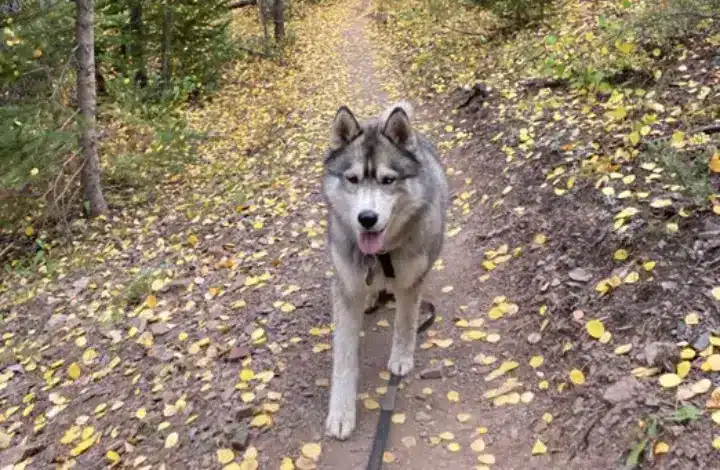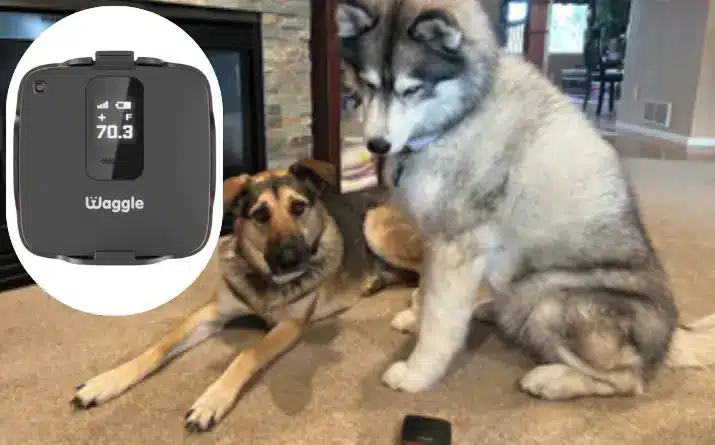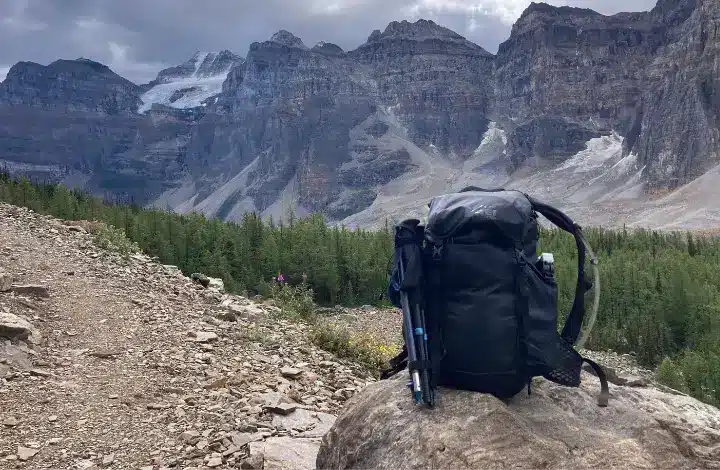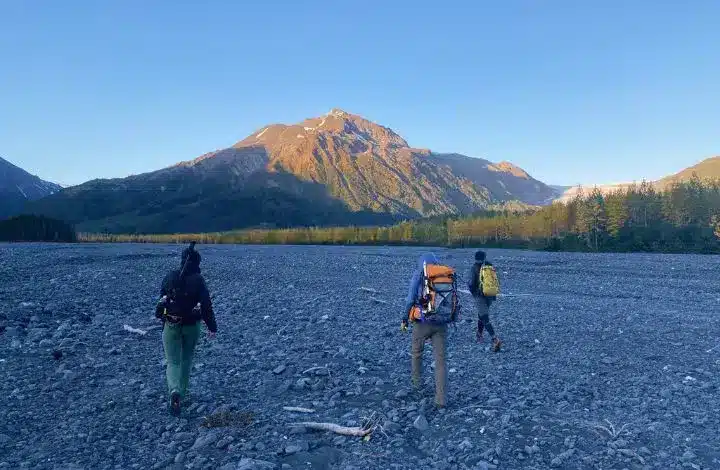17 Essential Tips to Keep Dogs Safe While Hiking
I don’t know about you, but I find exploring the great outdoors with my dogs to be one of life’s greatest pleasures. And I’m always mindful about how to keep my dogs safe while hiking. If you can spend quality time with an animal who has no idea what you’re saying most of the time—and I firmly believe that you can—hiking is a perfect example of that time.
It’s also the perfect entry point to adventuring outside with your dog, as just about anyone (and any dog) can do it. There are trails for every need, from flat, short, and paved to rugged, unmarked, multi-day trips.
Top Tips for Keeping Your Dog Safe and Healthy on Hikes
Whether you prefer a casual mile in the woods or a full-day epic journey summiting a high-elevation peak, there are some safety precautions you should take to keep yourself and your dog safe.
Read on for our top 17 tips to keep your dog safe and healthy on hikes, wherever you may roam.
Tip #1: Make Sure Dogs Are Allowed
Don’t assume your dog can hike everywhere you can. There’s no bigger bummer than reaching your trailhead and seeing a big sign that says “NO DOGS.”
I ran into this myself when I showed up at Colorado’s beautiful Mueller State Park for what I thought would be an epic few days of hiking with my dog. Unfortunately, when we arrived I found out that he wasn’t allowed on any of the trails.
While many national parks and state parks do allow dogs, they often have restrictions about where dogs are allowed to roam. Prevent unpleasant surprises and know before you go which trails are dog-friendly.
Tip #2: Pick Hiking Trails That Match Your Dog
A dog who has never hiked before probably shouldn’t go bouldering or sliding down scree, so make sure the trail you choose is a good match for your dog’s athletic ability and energy level. Your choice might vary based on their age, weight, breed, and general health.
For example, dogs with flat and short noses will do better on short hikes, whereas larger, more athletic breeds might romp straight up a mountain. If you’re unsure what kind of hike is safe for your dog, ask your vet before you hit the trail.
PAY ATTENTION TO TERRAIN AND TEMPERATURE
No matter how active your dog is, keep a close eye on the temperature and terrain. We’ll talk about overheating and keeping paw pads safe a little later, but just know that even a healthy and athletic dog will still need some protection from the elements.
I’m extra careful with my double-coated Siberian Husky in the summer. If temps will be above 80 degrees, I pick a hike with shade or start at the crack of dawn. Likewise, jackets can keep short-coated dogs warm on crisp weather days.
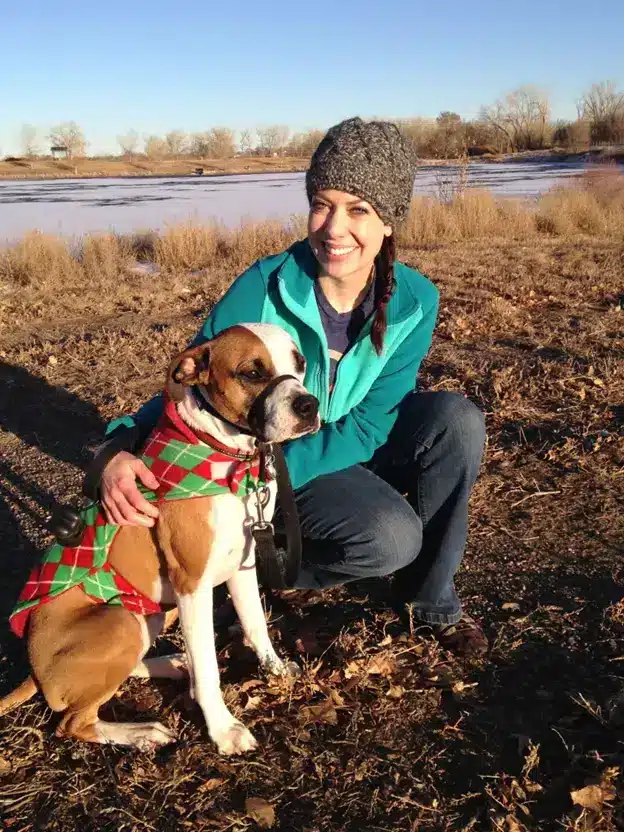
Tip #3: Bring Plenty of Water
Bring a collapsible water bowl or a dog water bottle, and stop regularly to give them a drink. Dedicate a water bottle or two to your dog so you both have enough to drink. (This also gives you a place to pour back any unused water so you don’t have to dump it out and waste it.)
BRING ENOUGH WATER
How much water does your dog need? In general, a good rule of thumb is one ounce per pound of your dog’s body weight per day, but they’ll need more than that if they’re working hard all day. Larger breeds also generally need more water than smaller dogs.
CONSIDER THE TEMPERATURE
Temperature is also a factor. On a very hot day, your dog will need more water to help them stay cool, just like you will. The safest option is to bring potable water or treat water for both yourself and your dog as you go.
If your pup loves to drink from streams and rivers, talk to your vet about a Leptospirosis vaccine before you hit the trails, and keep an eye out after your hike for symptoms of Giardia.
Collapsible dog bowls are lightweight and include an attached carabiner, making it easy to both store and carry while hiking.
Lightweight and portable with a convenient built-in bowl makes this dog water bottle easy to use on hikes and while camping with dogs.
Tip #4: Prevent Dogs from Overheating
You don’t have to go hiking in Death Valley to overheat your dog. A hot day and limited shade can do the trick, even at elevation, so watch your dog closely for signs of overheating.
WATCH FOR SYMPTOMS OF HEAT EXHAUSTION
The symptoms of a dog overheating that you should look out for include:
If your dog can’t seem to get their tongue back in their mouth, they’re too hot and need a cool-down break immediately. Dogs overheat faster than humans, so take it easy on hot days and seek out shade.
PACK A BANDANA
Cool your dog down with air conditioning if you can get back to the car, or use water to cool them down. Wet a bandana or towel and place it around their neck to provide a quick cooldown, or find a water source where they can soak for a bit.
Tip #5: Keep Your Dog on a Leash
I know—we all love the idea of our dog running carefree through the woods and exploring the trails to their heart’s delight. But unless your dog has excellent off-leash recall, meaning they will listen to your commands no matter what, you should keep them on leash for their own safety. This keeps them from having too-close encounters with wildlife or with other dogs on trail, some of whom might be unfriendly.
Also, lots of people and dogs don’t enjoy the sight of an off-leash strange dog running up to them, especially if you’re nowhere in sight. So make sure your dog stays within your line of sight at all times.
HANDHELD VS HANDS-FREE LEASHES
Leashes can also keep your dog safe on exposed or rugged terrain. All that said, don’t neglect your own safety. While hands-free dog leashes can be great, always take care in tricky areas to ensure your dog doesn’t pull you off balance.
I’ve been taken out at the waist more than once when my dog spotted a nearby squirrel. It’s nice to be able to drop the leash in a spooky moment if you need to.
Tip #6: Watch for Wildlife
On one hike near Rocky Mountain National Park, my dog Orion and I rounded a corner only to find a surprised moose just a few feet in front of us on the trail. Moose are notoriously aggressive toward dogs, especially if there’s a baby moose involved.
This one was a young male, but I wasn’t taking any chances. I dragged my dog out of there as quickly as we could go. Thankfully, he was on leash, as he was just dying to go say hi to the strange animal in front of us.
LEASHES HELP MAINTAIN SAFE DISTANCE FROM WILDLIFE
Other animals are one of the biggest potential hazards to your dog on trail. A leash is the best defense against wild predators like mountain lions and bears or defensive herbivores like moose and elk. Skunks and porcupines pose their own kind of threat, and even free-range cattle can get aggressive if they feel threatened.
Moreover, a loose dog can easily lead any of these wild animals right back to you. Always keep an eye out for wildlife and, when in doubt, keep your dog on leash to avoid any close encounters.
Tip #7: Don’t Forget the Flora
It isn’t just the fauna you should keep an eye on. Steer clear of harmful plants like poison ivy, stinging nettles, and foxglove.
BARBED GRASS SEEDS
Also, watch out for barbed grass seeds, often known as “foxtails.” These grasses are everywhere and can easily snag in your dog’s fur, between their toes, and even in their nose and mouth. If you see any, pull them out right away, as they can work their way through a dog’s skin and into vital organs.

Seriously, they won’t stop until they hit bone. If there are foxtails in the area, avoid walking through areas of tall wild grasses. After your hike, please remember to check your dog, including her armpits, between the toes, nostrils, and in the ear canal.

Orion spent most of one summer wearing t-shirts while he recovered from the removal of a foxtail that had gotten lodged in his abdomen and caused an infection.
Tip #8: Prepare for Safe Water Crossings
If your dog can’t swim and will need to cross a body of water with you, bring a dog life jacket and/or carry them across. Even good swimmers should not be allowed to attempt whitewater. Currents are often faster than they look and can be dangerous to even the best doggy athletes.
- Panels designed to move with dog
- Adjustable neck
- Durable webbing made for water use
- Handle for helping dog if needed
- Reflective accents for low light conditions
Also, bring a towel to dry your dog if they get wet. If they’re chilled by wet fur, hypothermia can impact dogs even in temperate weather.
Learn more about Ruffwear products.
Tip #9: Bring Snacks
Your dog probably won’t need to chow down on a bowl of kibble if you’re just taking a short stroll. A full-day hike, however, will definitely require some fuel.
Bring treats and extra kibble, and bump up their daily allotment of food to account for the extra activity. This is especially true if they’re carrying a pack and working extra hard to pull that additional weight around with them.
Tip #10: Buy or Build a First Aid Kit
Whether you buy a pre-made dog first aid kit or build your own, this essential item should be in your pack on every hike. If you make your own, be sure to include tweezers, alcohol wipes, gauze, and self-cling bandaging.
Medications like Benadryl are also good to have on hand in case of a bug bite or sting, and can even help in the event of a snake bite. Corn starch can be used to stop bleeding from a torn or damaged nail.
A simple bandana is also a handy item to include your kit. It can be soaked in cold water and tied around your dog’s neck to cool them down if they get too warm in the sun.
Tip #11: Can You Carry Your Dog Out?
If your dog is injured and can’t walk, you should have a plan in place to get them back to your car. Small dogs might be easy to carry for a bit, but if you’re hiking miles in, can you carry them back out?
EVACUATION PLAN AND CARRYING PACK
Consider bringing a carrier such as Ruffwear’s BackTrak Dog Evacuation Kit, which can help get even a large dog out of harm’s way.
Also, carry a lightweight muzzle just in case. As much as we don’t want to believe it, even our loving canine companion is capable of biting if they’re in pain. A muzzle can help keep everyone safe before you get your dog to the nearest vet.
Tip #12: Be Alert for Snakes
You might imagine rattlesnakes as desert creatures, but they can be found just about anywhere, including forests and swamps. The best defense against rattlesnakes is to avoid them, but sometimes bites happen.
So what should you do if your dog is bitten by a rattlesnake? First, get your dog away from the snake as quickly as possible. If you can do so safely, take a picture of the snake for your vet—but don’t get close enough to risk a bite. Clearing the area should be your top priority.
RESEARCH AREA IN ADVANCE
If you’re hiking in snake country, do some research ahead of time to find out which vets have the best stock of antivenom in the area.
Do not suck the venom out of the bite or enlarge and drain the wound. These actions have been found to be largely ineffective and even dangerous. Instead, keep your dog calm and comfortable and get them to a vet as quickly as possible.
If you can carry them and keep the wound below the heart, that may be able to slow the spread of the toxin in your dog’s bloodstream.
Tip #13: Don’t Neglect Basic Training
Before taking your dog on an adventure, be realistic about their level of training and general behavior, especially when they’re in a new environment. For example, a dog that’s reactive to people or other dogs is probably not a great candidate for a popular or narrow trail.
Start at home to make sure your dog understands basic commands like leave it, sit, and stay before you bring them along on a hike.
Tip #14: Check For Ticks
In the summer, ticks can be picked up just about anywhere. They’ve been found in every U.S. state and all over Canada, so don’t assume you’re off the hook if you aren’t hiking in a tick hotspot.
TICK PREVENTION AND REMOVAL
Double-coated dogs are especially hard to check, so consider a flea and tick preventative, especially during the summer months when ticks are most active.
If you find one, remove them with a tick remover or tweezers. The faster you get them out, the less likely they are to transmit disease to you or your pet. (Don’t forget to also check yourself for ticks.)
Tip #15: Carry Identification
Your dog shouldn’t go hiking without a current ID tag and a microchip in case you get separated. My husky is notoriously bad at listening if he gets off leash, so a GPS tracker helps provide extra peace of mind in case we accidentally get separated on the trail.
Real-time tracking to locate and track dog anywhere. Subscription required.
- Real-time tracking
- No distance limit
- Battery-operated with battery life up to 15 days
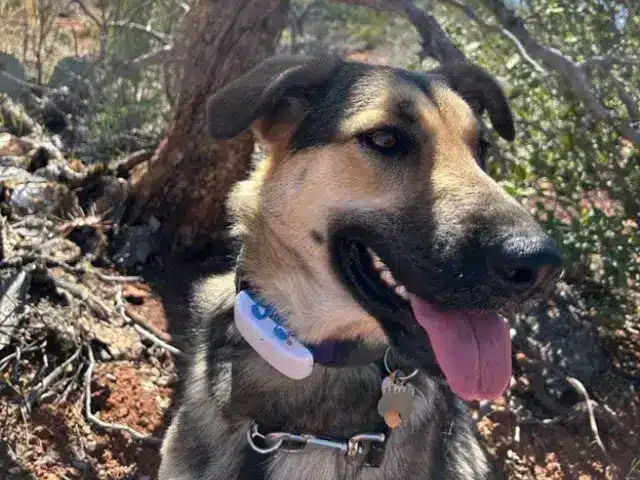
Tip #16: Use a Harness
When hiking, walk your dog on a harness instead of a collar, especially if you have a strong puller. There are all kinds of new sights, smells, and sounds on a hike that might turn your normally calm walking buddy into an Iditarod-level sled dog. Protect their neck by clipping their leash to a harness.

Tip #17: Pack Out the Poop
Nothing ruins a hike faster than stepping in a fresh pile of doggy doo, so keep the trail clean by packing out your dog’s droppings.
If they poop off trail, you can bury it instead of bagging it. Just remember that dogs eat processed kibble, not organic matter from your hike’s surroundings, so their poop is not a natural part of the environment.
Pack it out to leave no trace—especially if they go potty near a water source.
Dog Hiking Checklist
We’ve thrown a lot of tips at you, so here’s a handy dandy checklist to help you prep your hiking pack for your next adventure.
Here are the items to bring when hiking with your dog:
Conclusion
Dogs are incredible hiking partners. They never complain about the trail you’ve chosen, the weather, or your choice of snacks. (Not with words, anyway.)
Hitting the trail is the perfect opportunity to enjoy some bonding time with your dog and get a workout, too. With a bit of preparation, you can keep your time in the great outdoors safe and fun.
Read more:
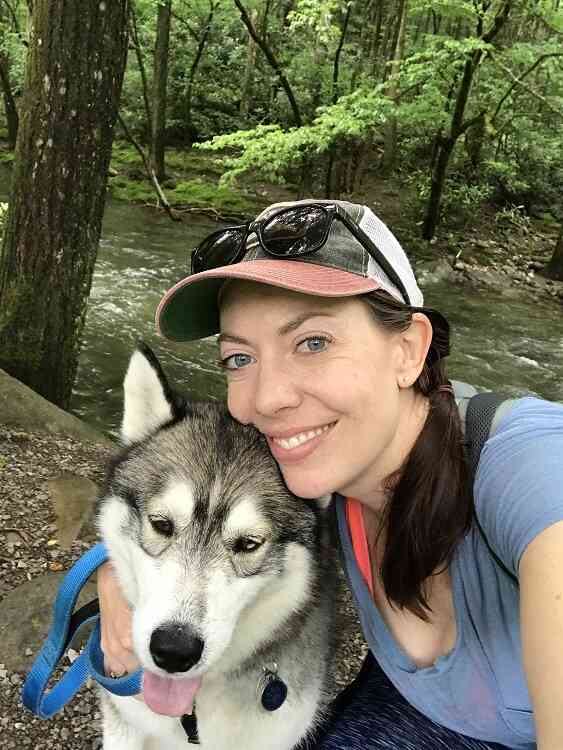
Sarah Kuiken has been a full-time solo traveler for 4 years and counting, but she’s been a solo adventurer for decades. She owns her own copywriting business, Flourish Writing, which she operates from the road. Sarah loves to explore state and national parks with her two dogs, Orion and Piper—wherever they’re allowed, of course. When she’s not whipping up web copy for fellow entrepreneurs, she’s probably out hiking or paddle boarding with the dogs in tow. Learn more about her freelance writing business at FlourishWriting.com.


